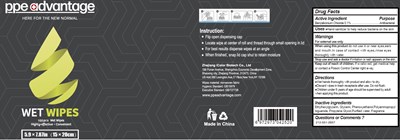Product Images Ppe Advantage Wet Wipes
View Photos of Packaging, Labels & Appearance
Product Label Images
The following 2 images provide visual information about the product associated with Ppe Advantage Wet Wipes NDC 74934-046 by Zhejiang Icolor Biotech Co., Ltd, such as packaging, labeling, and the appearance of the drug itself. This resource could be helpful for medical professionals, pharmacists, and patients seeking to verify medication information and ensure they have the correct product.
Bottle - Bottle

This is a product description of a package of 100 wet wipes that are designed to reduce bacteria on the skin. The wipes come with flip-open dispensing cap and are made from non-woven fabric. The active ingredient in the wipes is Benzalkonium Chloride, which serves as an antibacterial agent. The package also contains warnings and instructions for use. The product is manufactured by Zhejiang iColor Biotech Co., Ltd in China and the contact information is available on the package. The non-active ingredient in the wipes includes Ethylhexylglycerin, Glycerin, Phenoxyethanol, Polyaminopropylbiguanide, Propylene Glycol, Purified water, and Fragrance.*
Bottle2 - Bottle2

This is a description of a pack of wet wipes by PPE Advantage. The pack contains 220 pieces of highly-effective and convenient wet wipes, made in China by Zhejiang iColor Biotech Co., Ltd. The wipes are made of non-woven fabric and are accompanied by instructions on how to use them, including flipping open the dispensing cap, locating the wipe at the center of the roll, threading it through a small opening in the lid, and dispensing them at an angle. The wipes are designed for external use only, and contact with the eyes and mouth needs to be avoided. The product contains active ingredient nzakonium and is accompanied by warnings and directions for use. The pack provides the contact details of PPE Advantage, and any questions or comments can be directed through their phone number.*
* The product label images have been analyzed using a combination of traditional computing and machine learning techniques. It should be noted that the descriptions provided may not be entirely accurate as they are experimental in nature. Use the information in this page at your own discretion and risk.